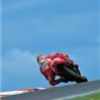Electronics
The Panigale isn't short on electronic gadgets, but they're not just bolted to the bike, they're an integral part of it. Ducati love an acronym and here are the ones they've crammed into the Panigale: Ducati Data Analyser (DDA+), Ducati Riding Modes (DRM), ABS, Ducati Electronic Suspension (DES), Ducati Traction Control (DTC), Ducati Quick Shift (DQS), Engine Brake Control (EBC) and full Ride-by-Wire (RbW).
DDA+ Ducati's Data Analyser comes as standard on the Panigale S Tricolore but is a whopping £2159 optional extra on the other models. Heavily revised from the original version, DDA+ maps your gear, speed, throttle position, DTC and coolant temp. If you also fit the GPS unit, (£323) it'll automatically time your laps and plot your lines which can be overlayed onto a Google Maps style satellite image. If your mates weren't bored enough of you rabbiting on about your new Panigale, they will be when you get the laptop out after your wobble 'round in the Inters.
DRM - Ducati's riding modes are standard on all models and work alongside lots of other features on the bike.
Race Riding Mode provides the track rider with an unrestricted 195hp with direct RbW throttle response and, on the ‘S’ version, an instant track-oriented suspension set-up. Race mode also reduces the DTC system intervention, provides a race-oriented EBC and front-only ABS with reduced anti-rear-lift-up and instantly reconfigures the instrumentation layout with a track-oriented display.
Sport Riding Mode provides the road or track rider with 195hp, delivered with a “smooth” RbW throttle response and, on the ‘S’ version, a sport-oriented suspension set-up. Sport mode slightly increases the DTC system intervention, provides a sport-oriented both EBC and front and rear ABS with incresed antirear-lift-up.
Wet Riding Mode provides the road or track rider with 120hp, delivered with a “smooth” RbW throttle response, increased DTC system intervention, environment-appropriate EBC, DQS off and fully enhanced ABS and, on the ‘S’ version, a suspension set-up optimised for low grip conditions.
ABS - As standard on the Tricolore S but an optional extra on the other models. It uses the latest generation 9ME Bosch processor and the system enables full ABS on the front only, when in Race mode. The system also boasts a “rear lift-up” detection which is activated in Sport and enhanced in Wet Riding Modes.
DES - Ducati Electronic Suspension. Only available on the S versions, in conjunction with the Öhlins front and rear suspension, rebound and compression is adjusted according to the chosen riding mode. User can also play with the suspension themselves and save their own modes. Look out!
DTC - Ducati Traction Control. Standard on all models and massively better than previous versions of DTC. It puts Ducati in the big league alongside Kawasaki (ZX-10R) and Aprilia (APRC RSV4 and Tuono V4). It features eight settings and retards the ignition as a first option, then limiting fuel injection if ignition retardation doesn't control wheelspin. It works extremely well, you can barely feel it working 95% of the time but you're aware it's working much more of the time because it allows you to get on the gas so much earlier than you're dare on a bike without it.
DQS - The electronic quickshifter first used on the 1198SP. It allows you to change-up without using the clutch, making gearchanges so much smoother and faster. It's most noticable when you're cranked over and on the power as you can accelerate hard and change gear without upsetting the bike.
RbW - Ride by Wire (throttle). Standard on all models, Ducati claim this setup allows them to ensure the mapping is as accurate as possible. It's precise but not aggressive (Ducati 1098R Bayliss, KTM RC8R, anyone?) Ducati got it right this time; there's no twitchyness or slow throttle response going on here.
EBC - Engine Brake Control. Standard on all models. Designed to keep the bike stable during hard braking. There's no doubt it works but I wasn't a huge fan of it. I like my bike to move around under braking so I can feel where I'm at. The system applies tiny throttle openings to balance the forces on the rear wheel and stopping it from sliding so much. It works: you can barely get the rear wheel to slide out under heavy braking unless you really poke it with a big stick. (Just watch the opening 3 seconds of this Panigale onboard lap to see it being poked. Then watch every other corner to see it working normally).
However, what I don't like about it is that when you go from a trailing front brake into corners, then letting off the brake compketely, the EBC, still working, gives the bike a tiny shove but enough to make you feel like you're understeering. You can adapt and ride around it. Others on the launch turned it to its least intrusive setting and said it transformed the way the Panigale got into corners on the brakes. As you can see from the picture above, it doesn't make you miss apexes; the Panigale is still pin-point, you only notice the downside to EBC on a couple of really slow corners at a circuit like Yas Marina.
Liked this article? Want more? You can read about the technical features and specs of the new Ducati Panigale here.

